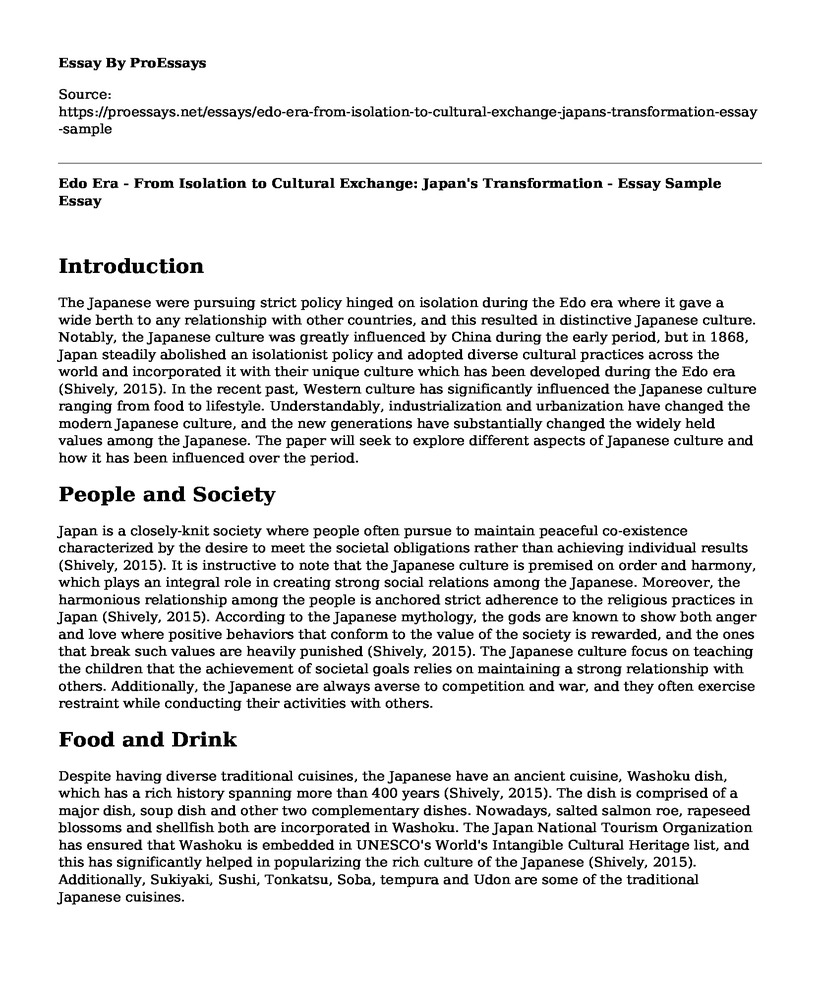Introduction
The Japanese were pursuing strict policy hinged on isolation during the Edo era where it gave a wide berth to any relationship with other countries, and this resulted in distinctive Japanese culture. Notably, the Japanese culture was greatly influenced by China during the early period, but in 1868, Japan steadily abolished an isolationist policy and adopted diverse cultural practices across the world and incorporated it with their unique culture which has been developed during the Edo era (Shively, 2015). In the recent past, Western culture has significantly influenced the Japanese culture ranging from food to lifestyle. Understandably, industrialization and urbanization have changed the modern Japanese culture, and the new generations have substantially changed the widely held values among the Japanese. The paper will seek to explore different aspects of Japanese culture and how it has been influenced over the period.
People and Society
Japan is a closely-knit society where people often pursue to maintain peaceful co-existence characterized by the desire to meet the societal obligations rather than achieving individual results (Shively, 2015). It is instructive to note that the Japanese culture is premised on order and harmony, which plays an integral role in creating strong social relations among the Japanese. Moreover, the harmonious relationship among the people is anchored strict adherence to the religious practices in Japan (Shively, 2015). According to the Japanese mythology, the gods are known to show both anger and love where positive behaviors that conform to the value of the society is rewarded, and the ones that break such values are heavily punished (Shively, 2015). The Japanese culture focus on teaching the children that the achievement of societal goals relies on maintaining a strong relationship with others. Additionally, the Japanese are always averse to competition and war, and they often exercise restraint while conducting their activities with others.
Food and Drink
Despite having diverse traditional cuisines, the Japanese have an ancient cuisine, Washoku dish, which has a rich history spanning more than 400 years (Shively, 2015). The dish is comprised of a major dish, soup dish and other two complementary dishes. Nowadays, salted salmon roe, rapeseed blossoms and shellfish both are incorporated in Washoku. The Japan National Tourism Organization has ensured that Washoku is embedded in UNESCO's World's Intangible Cultural Heritage list, and this has significantly helped in popularizing the rich culture of the Japanese (Shively, 2015). Additionally, Sukiyaki, Sushi, Tonkatsu, Soba, tempura and Udon are some of the traditional Japanese cuisines.
Music and Dance
The traditional Japanese dances are featured by sluggish gesturing and music supplement. For instance, the Bon Odori dance is performed during a summer festival in most cities of Japan. During the dance, the Japanese wear kimonos while dancing using gestures and corresponding steps to the music. The Bon Odori dance is linked to the Bon Festival which takes place during August in the commemoration of the ancestors. Another traditional dance is called Nihan Buyo which is performed when people wear kimonos and other items like the Japanese rope and fans. The teachers teaching such dances are referred to as Shisho. Additionally, Noh Mai style is accompanied by background music and a supplemented of lutes and drums. Kabuki is also popular traditional dance and dramas and tells a lot of stories especially on the history, the society and the Japanese lifestyle. Some of the instruments used in traditional music include Shakuhachi flute, koto string and wadakio drums, among others.
Traditional Clothing
The traditional clothing for the Japanese is commonly known as the wafuku. More significantly, the wafuku clothing is also supplemented by other clothes, but the type of clothes worn depends on the age of the individuals and the occasion. The kimono is traditional clothing for both men and women, and nagajuban is a cloth worn under the kimono. The haori clothing is a short hip jacket used by both men and women. Similarly, the Michio Yuki is a jacket that the Japanese use on top of the kimono robe. The hakama is a garment which is worn by men and women, and it can also be worn with kimono. More imperatively, the special kimono referred to as the Yukatas is worn during the summer events, especially family occasions. They are purposed for use when there is an informal event like a family fete. In events like wedding, uchikake, which is a wedding kimono is worn by men, but women use the Shiro-maku, which is a white wedding gown.
Conclusion
The culture of Japan is ancient, divine, diverse and evolved from the prehistoric period to the contemporary period. It has influenced many facets of modern Japan. The culture ranges from diet to music and dance, people and the society to fashions as well as sports. Most of the clothes used by the Japanese include uchikake, Michio Yuki, and Shiro-maku, among others. The Japanese also several dances in performing different events including the Bon Odori. Their cultures were diversified including the Washoku dish which comprises of salted salmon roe and rapeseed blossoms. The washoku has gain popularity reaching the records of the UNESCO World Intangible Cultural Heritage.
Reference
Shively, D. H. (Ed.). (2015). Tradition and modernization in Japanese culture. Princeton University Press. https://books.google.co.ke/books?hl=en&lr=&id=MnN9BgAAQBAJ&oi=fnd&pg=PP1&
Cite this page
Edo Era - From Isolation to Cultural Exchange: Japan's Transformation - Essay Sample. (2023, Feb 14). Retrieved from https://proessays.net/essays/edo-era-from-isolation-to-cultural-exchange-japans-transformation-essay-sample
If you are the original author of this essay and no longer wish to have it published on the ProEssays website, please click below to request its removal:
- Paper Example on Naturalism, Realism, Modernism in Literature
- Polis to Cosmopolis in the Early Greek Philosophy Paper Example
- Reign of Gregory VII Questions and Answers Paper Example
- Paper Example on Media's Role in U.S. National Security Since WWII
- Essay Sample on Exploring Old, Weird America with Frederick Law Olmsted
- Obedience & Conformity: Rules, Beliefs & Behaviour - Essay Sample
- Free Essay Sample on Deviance in 18th and 19th Century US: Incest and Social Control







